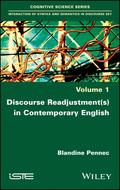Discourse Readjustment(s) in Contemporary English

1. Edition March 2018
384 Pages, Hardcover
Wiley & Sons Ltd
This study examines the linguistic tools which enable speakers and writers to propose adjustments and re-adjustments of the sentences they've just produced, as well as the goals they fulfil by doing so. We examine corrections, reformulations, specifications, modifications of points of views and link them with discursive strategies. (Re)-adjustments can be made in order to express oneself in a better way, to favor comprehension by adapting to the addressee, to structure one's intervention, to play on the potentialities of language (polysemy, homonymy, ambiguity), to mention the main purposes associated with the use of those devices. The study focuses on the markers associated with those strategies. Therefore, it links the syntactic, semantic and pragmatic levels.
1. Definitions. Inter-comprehension, adjustments, re-adjustments and inter-subjectivity.
2. Reasons leading to discourse re-adjustments.
3. Typology of discourse re-adjustments.
Part 2. Reformulations: re-adjustments leading to a better form of expression?
1. The role of reformulations within language and discourse.
2. The notion of reformulation and the corresponding linguistic tools.
3. The discursive strategies linked with the use of reformulations.
Part 3. Gradations, downgrading and refocusing processes: re-adjustments leading to reposition oneself?
1. Re-focusing processes. Constructions using in fact and remarks about competing markers.
2. Gradations and downgrading processes: the study of the fixed phrases and even and or at least.
3. Gradations suggested: the case of the sequence if not.
Part 4. Distance taking and revisions: re-adjustments permitting to change one's point of view?
1. Distance taking: the study of anyway and remarks about competing fixed phrases.
2. The use of now: from its use as a deictic to its use as a marker of re-adjustment.
3. The fixed phrase after all: the reconsideration of a point of view.
Part 5. Metalinguistic expressions, parenthetical and dialogical segments: re-adjustments enabling speakers to play with language?
1. The use of metalinguistic expressions: re-adjustments with rhetorical purposes.
2. Parenthetical segments: plays on different levels of expression.
3. Study of constructions using it is not that....it is that...: a strong dialogical dimension.
Part 6. Discourse markers: re-adjustments used to better structure oral speech?
1. The expression I mean: a "gap filler" but also a marker of re-adjustment.
2. The case of you know and you see: markers creating a participation framework.
3. The use of mind you: how to counter the hearer's expectations.


